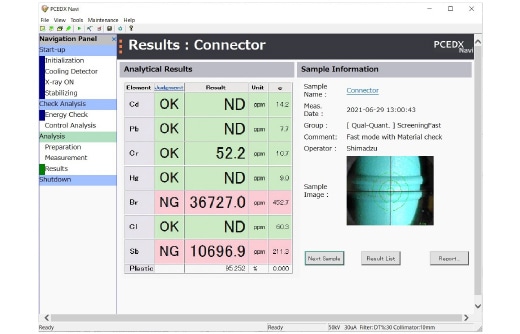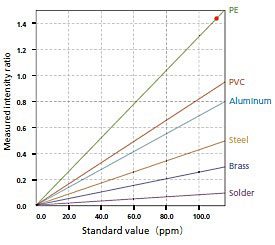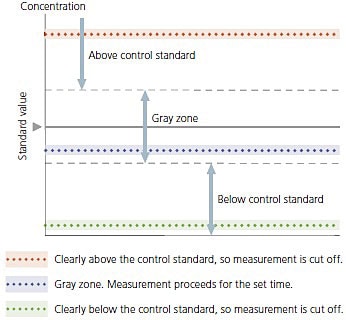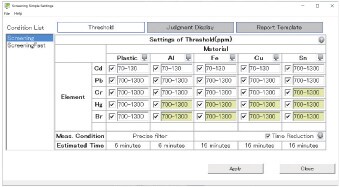EDX-8100 - Options
Energy Dispersive X-ray Fluorescence Spectrometer
Screening Analysis Kits
Ideal for RoHS, ELV, and Halogen Screening
The optional screening analysis kits allow even beginners to start RoHS, halogen, or antimony screening analysis right from the day of purchase. Simply mount the sample, select the analysis conditions, enter the sample name, and wait for the results. The analysis results are displayed with a pass/fail evaluation after just a few minutes.

Analytical results window using the RoHS, Halogen and Antimony screening kit
Internal Calibration Curves and Automatic Calibration Curve Selection

Internal calibration curves
Internal calibration curves are provided for many materials, making it unnecessary to provide a large number of standard samples.
Automatic calibration curve selection
The software automatically selects the best calibration curve for the material, freeing the user from the need to select analysis conditions.
As an incorrect calibration curve selection can result in large error in the quantitation results, this function contributes to improved data reliability.
Shape correction
The fluorescent X-ray and scattered X-ray intensities are compared for each element (BG internal standard method) to eliminate the effects of the sample shape and thickness in the quantitation values.
Automatic Measurement Time Reduction

This function automatically switches to the next analysis channel if a controlled substance clearly has a high or low concentration, making evaluation possible while measurement is underway. This achieves more efficient screening analysis.
Screening Simple Setup Screen

Simple Setup Screen of RoHS Screening Analysis Kit
Threshold Values
A threshold value can be set for each material and element. The screening evaluation method changes according to how the threshold values are set.
Evaluation Character String
Character strings can be set for display in the analysis results when the threshold value is not exceeded, in the gray zone, and when the threshold value is exceeded.
Report Template
Set the report style from among the templates supplied as standard.
Three screening Analysis kits are available to suit dif ferent applications.

RoHS Screening Analysis Kit
Kit for screening cadmium, lead, mercury, chromium, and bromine. Polyethylene samples containing these five elements are supplied in the kit for instrument management.

RoHS and Halogen Screening Analysis Kit
In addition to cadmium, lead, mercury, chromium, and bromine, this kit also supports the screening of chlorine in plastics. Polyethylene samples containing these six elements are supplied in the kit for instrument management.

RoHS, Halogen, and Antimony Screening Analysis Kit
In addition to cadmium, lead, mercury, chromium, and bromine, this kit also supports the screening of chlorine and antimony in plastics. Polyethylene samples containing these seven elements are supplied in the kit for instrument management.
EDX-8100 Options
EDX-FTIR Contaminant Finder/Material Inspector EDXIR-Analysis software
By measuring the sample with both EDX and FTIR systems and using EDXIR-Analysis to analyze both EDX and FTIR data, elements can be identified automatically with high accuracy.
Small Spot Analysis Kit
This kit is especially useful for analyzing trace foreign matters and micro areas.
This combination includes a 0.3 mm diameter collimator and high resolution camera.
Sample Holder/Stocker for Contaminant Measurement EDXIR-Holder
Measure the Samples Kept in the Holder with EDX and FTIR
The Holder Can Be Used as the Sample Stocker after the Measurement
- ■ Vacuum Measurement Unit
Use this unit for sensitive measurements of light elements. It requires space for installation of a rotary pump and switch box at the side or rear of the desk supporting the main unit.
- ■ Helium Purge Unit
This unit is used for highly sensitive measurements of light elements in liquid samples. Does not include a helium cylinder or regulator.
(Option for EDX-7000)
- ■ Turret Unit

Turret for 12 samples. It permits continuous measurements of samples up to 32 mm in diameter. It improves throughput, especially for measurements in a vacuum or helium atmosphere.
- ■ Screening Analysis Kits
RoHS/ELV Screening Analysis Kit
- With check samples for five elements
RoHS and Halogen Screening Analysis Kit
- With check samples for six elements
RoHS, Halogen, and Antimony Screening Analysis Kit
- With check samples for seven elements
- ■ Polyester Film
Sample-holding film (for heavy element analysis)
- ■ Polypropylene Film
Sample-holding film (for light element analysis)
- ■ Sample Cells

3571 General Open-End X-Cell
(no lid)
(Outer diameter: 31.6 mm, volume: 10 mL)
Polyethylene sample cell for liquid and powder samples.

3529 General X-Cell (with lid)
(Outer diameter: 32 mm, volume: 8 mL)
For liquid samples. Equipped with a relief hole and liquid retainer in case of liquid expansion.

3577 Micro X-Cell
(Outer diameter: 31.6 mm, volume: 0.5 mL)
For trace samples. Recommended for use with a collimator.

3561 Universal X-Cell
(Outer diameter: 31.6 mm, volume: 8 mL)
For liquid and thin-film samples. Equipped with a relief hole and liquid retainer in case of liquid expansion. Equipped with a ring to tightly hold thin-film samples with film.
Features
- Minimum 0.3 mm X-Ray Irradiation Diameter
The excitation X-rays can be collimated to 0.3 mm in diameter, which is effective for the high-accuracy analysis of small contaminants and for defect analysis in small regions, analyses difficult with standard specifications (minimum 1 mm in diameter). - Enlarged Sample Images without Image Quality Degradation
This system supports smaller samples, which heightens the visibility of sample observation images. Users can switch to an enlarged image approximately 2.5 times larger than a previous image, without image quality degradation. - Automatic Four-Stage Switching Between 0.3, 1, 3, and 10 mm in Diameter
The irradiation diameter automatically switches between 0.3, 1, 3, and 10 mm in diameter. This system supports not only the analysis of small spots but also macro composition analysis at 10 mm in diameter.
Note: The irradiation diameter is the size on the sample surface.

Analysis Example
Small Metal Powder (Approx. 0.1 mm in Diameter) Adhered to the Surface of Snacks
A small metal powder approximately 0.1 mm in diameter adhered to the commercially available snacks was analyzed with irradiation diameters of 1 mm and 0.3 mm respectively. At an irradiation diameter of 1 mm, the overall background is significantly increased due to the influence of scattered X-rays from the surrounding area of the metal powder (snacks), resulting in a poor S/N ratio. At an irradiation diameter of 0.3 mm however, the influence of scattered X-rays from the surrounding area is small, and peak profiles with a good S/N ratio are obtained.Copper (Cu) and Zinc (Zn) are detected as the major component with both irradiation diameters. It indicates that the metal powder is brass regardless of the irradiation diameter used. However, at 0.3 mm in diameter, the peak of Lead (Pb) is also identified, which suggests that the metal powder is not only the brass, but the "free cutting brass" contains Lead.
By using an irradiation diameter of 0.3 mm, more accurate analyses can be performed, even for small contaminants on substance such as organic materials that strongly scatter X-rays.

Also Capable of Film Thickness Measurements for Small Spots of Plating
When film thickness measurements are performed with the calibration curve method or the thin-film FP method, the sample (measurement position) must be larger than the X-ray irradiation diameter. This system supports film thickness measurements for small spots of plating, which were difficult at an irradiation diameter of 1 mm.

EDX-FTIR Contaminant Finder/Material Inspector EDXIR-Analysis
Provides Strong Support for Contaminant Identification Analysis

High-accuracy identification analysis can be performed automatically by measuring one sample with EDX and FTIR, and then analyzing both data sets with EDXIR-Analysis.
For more details, visit
EDXIR-Analysis






